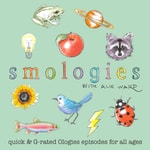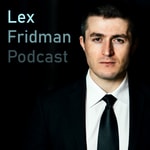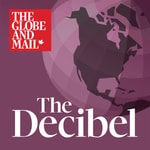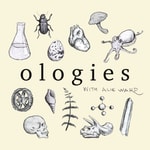Big Biology – Détails, épisodes et analyse
Détails du podcast
Informations techniques et générales issues du flux RSS du podcast.
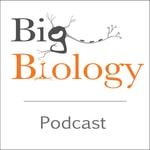
Big Biology
Art Woods, Cam Ghalambor, and Marty Martin
Fréquence : 1 épisode/16j. Total Éps: 159

Classements récents
Dernières positions dans les classements Apple Podcasts et Spotify.
Apple Podcasts
🇨🇦 Canada - lifeSciences
26/09/2024#21🇬🇧 Grande Bretagne - lifeSciences
26/09/2024#19🇺🇸 États-Unis - lifeSciences
26/09/2024#30🇫🇷 France - lifeSciences
26/09/2024#39🇨🇦 Canada - lifeSciences
25/09/2024#96🇬🇧 Grande Bretagne - lifeSciences
25/09/2024#13🇺🇸 États-Unis - lifeSciences
25/09/2024#34🇫🇷 France - lifeSciences
25/09/2024#18🇨🇦 Canada - lifeSciences
24/09/2024#83🇬🇧 Grande Bretagne - lifeSciences
24/09/2024#14
Spotify
Aucun classement récent disponible
Liens partagés entre épisodes et podcasts
Liens présents dans les descriptions d'épisodes et autres podcasts les utilisant également.
See all- https://twitter.com/WalterIsaacson
11 partages
- https://twitter.com/GSI_Exeter
4 partages
- https://twitter.com/KevinJGaston
2 partages
- https://www.patreon.com/bigbio
12 partages
Qualité et score du flux RSS
Évaluation technique de la qualité et de la structure du flux RSS.
See allScore global : 43%
Historique des publications
Répartition mensuelle des publications d'épisodes au fil des années.
Ahead of the (thermal) curve (Ep 122)
Saison 7 · Épisode 122
jeudi 12 septembre 2024 • Durée 01:16:42
How do biologists study the influence of heat on organisms and how can this be applied to the study of climate change? What impacts mountaineer survival at high altitudes?
On this episode of Big Biology, we talk with Professor Emeritus at University of Washington and recently elected member of the National Academy of Sciences, Ray Huey. Ray is well known for his work on the thermal physiology of lizards, but has also worked broadly in physiology, ecology, and evolution. In our conversation with Ray, we first discuss his paper, an “Acynical Guide to Graduate School,” and it ongoing relevance to graduate students. We then talk about his career path into thermal biology, how he became interested in the science of mountaineering, and his philosophy for writing science.
Art by Keating Shahmehri. Find a transcript of this episode on our website.
Long-term experimental evolution in the wild (Ep 106)
Saison 6 · Épisode 106
mardi 27 août 2024 • Durée 01:07:53
Can we predict evolutionary outcomes if we know starting conditions? Do the products of evolution in nature differ from those studied in well-controlled lab experiments?
On this episode, we talk to Katie Peichel, head of the Division of Evolutionary Ecology at the University of Bern, Switzerland, and Andrew Hendry, professor in the Department of Biology at McGill University, Canada. Katie and Andrew are part of a massive research team working on the evolution of threespine sticklebacks as they are reintroduced into lakes in Alaska. Sticklebacks have been a favorite species for evolutionary biologists since almost the origins of modern evolutionary theory. Traits like spine size and lateral plate armor evolve rapidly when populations colonize new habitats, leading populations to barely resemble one another. Unlike traditional evolutionary experiments, which try to infer what occurred in the past, the Alaska project is tracking in unparalleled detail changes in the phenotypes and genotypes of fish that went into each lake population.
We talk to Katie and Andrew about the origins of this incredible project, the pros and cons of different approaches to studying evolution, and the need for long-term experimental studies of evolution in the wild. This is the first of a series of episodes we will be doing on the Alaskan research project, so stay tuned!
Cover art: Keating Shahmehri
Does a porpoise have a purpose? Agency and goals in evolution (Ep 115)
Saison 6 · Épisode 115
jeudi 8 février 2024 • Durée 01:09:42
What is an agent, and does an organism have to be conscious to be one? How does organismal agency affect evolution?
In this episode, we talk with Samir Okasha, a Professor of Philosophy of Science at the University of Bristol. Samir studies fundamental philosophical questions in evolutionary biology, most notably how selection acts on various levels of biological organization. Our discussion focuses on his book “Agents and Goals in Evolution,” in which he unpacks various definitions of agency and outlines their evolutionary implications. We talk about whether genes and groups of individuals can be agents, whether agency is heritable, where variation in agency comes from, and the relationship between agency and adaptation.
Cover art: Keating Shahmehri. Find a transcript of this episode on our website.
Ep 45: Student Spotlight
Saison 2 · Épisode 45
jeudi 25 juin 2020 • Durée 01:07:39
How are early stage scientists pushing biology forward? What’s it like to be a graduate student during a global pandemic?
Over the last several months, we’ve been collecting short audio clips from biology students describing their research. Associate Producer Michael Levin spearheaded the project, which we called the Student Spotlight.
On this episode of Big Biology, we talk with four students who submitted the best audio clips for that project. We talked about their science, and also asked them about the most important areas for future research, advice for future biology students and what it’s like to be a young scientist when a global pandemic is making the future uncertain.
The episode features Andrew Burchill at Arizona State; Ruth Demree, who recently graduated from Vassar; and Jason Hagani and Laura Plimpton, both at Columbia
Ep 44: The Science of Slime
Saison 1 · Épisode 4
vendredi 12 juin 2020 • Durée 59:52
What’s the slimiest fish on Earth? Why are they so slimy? And can we leverage our understanding of slime to make better bioengineered materials?
In this episode we talk with Doug Fudge, an Associate Professor at Chapman University, about his research on hagfish slime. Over the past 20 years, Doug and his lab and collaborators have figured out how and why hagfish produce slime, how the slime’s remarkable properties emerge from its underlying chemistry, and whether the protein threads in slime can be used to make bio-inspired fabrics that are greener, better, and longer lasting.
A significant portion of Doug’s work has been published in Journal of Experimental Biology, including this 2005 paper on the composition and structure of hagfish slime and this 2006 paper testing a key hypothesis about how hagfish use slime to defend themselves from predators. Fudge’s lab published recent papers on how slime glands refill after they eject their slimy contents and how they chemically stabilize coiled threads inside the glands before they are ejected. Papers in other journals explore how slime threads can be used to make bio-inspired fabrics and how slime threads are constructed and mature inside slime glands.
Ep 43: Project ICARUS
Saison 1 · Épisode 43
jeudi 28 mai 2020 • Durée 01:08:34
What can we learn from animals by constantly tracking their movements with transmitters? How can we use information from collectives of animals to study and predict disease spread, earthquakes, and outbreaks of pests? How do you transform a massive, international scientific idea into a reality?
On this episode of Big Biology, we talk with Martin Wikelski, the Director of the Max Planck Institute for Animal Behavior. Martin leads Project ICARUS, an international collaboration aiming to track thousands of tagged animals at once from space. We talked with him about the long road to getting the project off the ground and what will ultimately learn from this new and powerful tool.
Photo: © MPIAB Jacob Stierle
Ep 42: Fatal Fungus
Saison 2 · Épisode 42
vendredi 15 mai 2020 • Durée 42:04
Why are amphibians across the world dying from a fungal infection? Where did the fungus come from? How does it kill and are populations adapting?
On this episode of Big Biology, we talk with Craig Franklin, a biologist at the University of Queensland and the director of research for the Steve Irwin Wildlife Reserve, about the history and distribution of the fungus, how it’s killing so many species, and what we can do to save them.
Cover photo by Brian Gratwicke.
Ep 41: Coronavirus II
Saison 2 · Épisode 42
jeudi 30 avril 2020 • Durée 45:54
Where did the new coronavirus come from? How can we be on the lookout for new diseases emerging from animals? Now that the coronavirus has infected humans, what’s the best path forward? In this episode of Big Biology, we talk with Andy Dobson, a disease ecologist at Princeton University who studies epidemics like the current COVID-19 outbreak. We talked with him about the possible animal origins of the virus, the best way to control its spread and strategies to avoid the next pandemic. Andy emphasizes that we shouldn’t blame wildlife for the coronavirus outbreak. It’s human behavior that led to this problem, and it’s human behavior that’s going to have to change to avoid the next ones. This episode is dedicated to Robert May,
We need your help to make season three!
Saison 2 · Épisode 41
mardi 21 avril 2020 • Durée 01:49
We’re getting ready for season three next fall. We already have a bunch of great guests lined up to talk about the evolution of venom, insect intelligence and human evolution.
But we need your financial support to make that happen. Our goal is to raise at least $1,500 from listeners. If we aren’t able to accomplish that, we’ll need to drastically scale back production for season three.
We know this is a tough time to ask for your help, but if you’re able, we would really appreciate your financial support.
We know our listeners love Big Biology. If you want it to continue in its current format then go to our Patreon page Patreon.com/bigbio and make a recurring donation. You can also make a one time donation at our website: bigbiology.org.
This is a make or break moment for the podcast and we need our listeners to support us. You can make a donation at Patreon.com/bigbio and BigBiology.org.
Thanks so much for listening. We hope all of you are staying safe!
Ep 40: Songbird Scents
Saison 2 · Épisode 40
jeudi 16 avril 2020 • Durée 01:11:47
How do hormones like testosterone coordinate important activities in an animal’s life, and how might those activities tradeoff with one another? How do the microbial communities living on birds affect the scents they give off, and how do those scents influence the birds’ choices of mates?
In this episode, we talk with Ellen Ketterson, an evolutionary biologist at Indiana University, Bloomington, about her work on juncos in North America. We discuss Ellen’s early research on how testosterone modulates life history characteristics of male juncos. We also discuss her more recent work on bird microbiomes and their roles in bird olfaction and mating, and the physiological underpinnings of migratory behaviors. Finally, we talk about some big ideas about the philosophy of doing biology -- including the value of building scientific efforts around model versus natural systems, paths to integration in biology, and how to mentor students effectively.





